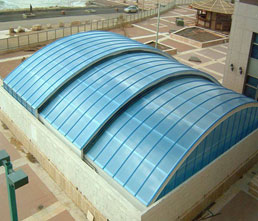Polycarbonate Solid Transparent Sheet
Polycarbonate Solid Transparent Sheet











Product Details
- Our Range
- Standard Dimension
- Physical
- Installation
- Cleaning & maintenance
| Colour & Tints | Clear,Blue,Green, Bronze, Solar Grey (as per requirements) |
| Thickness | 0.8mm to 15mm |
| Standard Width | 915mm - 2135mm (Can be Customised) |
| Standard Length | 2440mm or 30500mm(Can be Customised) |
| Light Transmission | 92%(clear) |
| Options | One Side UV, Both Side UV, Strong Adhesive film |
| Specials | Anti fog & Solar Control Option Available |
| Sheet Size(mm) | Sheet Thickness(mm) |
| 915 x 30500 | 1.3, 1.5, 2, 3, 5 |
| 1220 x 30500 | 0.8 ,1 ,1.3 ,1.5 ,2 ,3 ,4 |
| 1525 x 30500 | 1.3, 1.5, 2, 3, 5 |
| 1830 x 30500 | 1.3, 1.5, 2, 3, 5 |
| 2135 x 30500 | 1.3, 1.5, 2, 3, 5 |
| 1220 x 2440 | 1.3, 1.5, 2, 3, 4, 5, 6, 8, 10, 12, 15 |
| PROPERTIES | TEST METHOD | VALUE | UNITS | |
| Physical Properties | Density | DIN 53479 | 1.2 | g/cm3 |
| Water Absorption in | DIN 53495:A | 0.35 | % | |
| Water Permeability | DIN 53122 | <2.28 | g/cm3 | |
| Mechanical Properties | Tensile Strength at Yield | DIN 53455 | >60 | MPa |
| Tensile Strength at Break | DIN 53455 | >70 | Mpa | |
| Tensile Modulus | DIN 53457 | 2300 | MPa | |
| Impact Strength @ 23°C | DIN 53453 | 50 | kJ/m2 | |
| Optical Properties | Light Transmission | DIN 5036 | 87-91 | % |
| Refractive Index | DIN 53491 | 1,586 | ||
| Thermal Properties | Coefficient of Thermal | DIN 53752 | 68 | m/m.KX10 .6 |
| Thermal Conductivity | DIN 52612 | 0.2 | W/m.K | |
| Maximum Continuous | >100 | °C | ||
Installation Guide: Polycarbonate Solid Sheets
This guide provides general instructions for installing solid polycarbonate sheets,For detailed information and product-specific recommendations, please refer to our comprehensive installation catalogue.
Safety First: Ensure optimal protection by wearing gloves, safety glasses, and long sleeves when handling polycarbonate sheets.
Proper Storage: Store sheets flat on a stable surface, protected from direct sunlight and weather to prevent warping or damage.
Acclimatisation: If the sheets have been in cold storage, allow them to adjust to room temperature before installation to minimise warping.
Gather Tools: Assemble the necessary tools, including a utility knife, saw (circular or jigsaw recommended for cleaner cuts), drill, and screwdriver.
General Installation Steps
- 1. Preparation
- 2. Support Structure
- 3. Cutting and Drilling
- 4. Fastening
- 5. Sealing (Optional)
- 6. Protective Film Removal
Measure and Cut: Carefully measure the installation area and cut the polycarbonate sheet to size, leaving a small gap for thermal expansion (consult the catalogue for specific recommendations on gap size).
Identify UV Protection: Locate the UV-protected side of the sheet (usually marked with a film). This side should face upwards during installation for maximum UV protection
Strength and Level: Ensure your support structure (framing, rafters, etc.) is level, plumb, and can handle the weight of the polycarbonate sheets. Refer to the catalogue for recommended spacing between support beams to ensure proper load distribution.
Sharp Cuts: Use a sharp blade or saw to cut the polycarbonate sheet, ensuring clean and precise cuts. Avoid scoring or scratching the surface to maintain its integrity.
Proper Drilling: Drill holes at least 2-3 times the diameter of the fastener away from the sheet's edge to prevent cracking. Use drill bits specifically designed for plastics for optimal results.
Appropriate Fasteners: Use appropriate fasteners with washers designed for polycarbonate sheets to ensure a secure and weatherproof connection. Do not over-tighten, as this can cause the sheet to crack.
Thermal Expansion: Allow for thermal expansion by using slightly oversized holes and slotted fastening points (consult the catalogue for details on recommended hole size and slot design).
Enhanced Weatherproofing: For certain applications, a silicone sealant compatible with polycarbonate may be used to improve weatherproofing. Refer to the catalogue for specific sealant recommendations to ensure compatibility.
Final Touches: Once installation is complete, carefully peel off the protective film from both sides of the sheet to reveal the brilliant clarity or rich color of the polycarbonate.
Remember: This is a general guide. Always refer to the detailed installation catalogue for specific instructions and recommendations for your particular polycarbonate sheet product to ensure a successful and long-lasting installation.
Cleaning and Maintaining Polycarbonate Solid Sheets
Polycarbonate solid sheets, including transparent, translucent, and opaque varieties, are known for their durability and clarity. To ensure they stay looking their best and function optimally for years to come, follow these simple cleaning and maintenance tips:
1. Regular Cleaning: Gently clean your polycarbonate sheets periodically to remove dirt, dust, and debris. Here's what you'll need:
o Mild soap solution (dish soap works well)
o Lukewarm water
o Soft cloths (microfiber cloths are ideal)
2. Mix the soap solution with lukewarm water. Dip your soft cloth into the solution, wring it out to avoid dripping, and wipe down the polycarbonate sheet. Rinse the sheet thoroughly with clean water to remove any soap residue. Finally, dry the sheet with another soft, lint-free cloth to prevent streaks.
3. Avoid Harsh Chemicals: Polycarbonate is susceptible to damage from harsh chemicals, abrasive cleaners, and solvents. These can cause the surface to become dull or even crack. Stick to the mild soap solution for routine cleaning.
4. Toughest Stains: For tougher stains or grime, you can use a diluted solution of white vinegar and water. Apply the solution with a soft cloth, gently scrub the stain, and then rinse the area thoroughly with clean water.
5. Scratch Prevention: Polycarbonate can scratch if not handled carefully. Avoid using abrasive materials or dragging objects across the surface.
6. Additional Tips:
o Consider using polycarbonate-specific tapes for temporary fixing or masking during other maintenance tasks to further protect the sheet from scratches.
o While polycarbonate is naturally weather-resistant, regular cleaning helps maintain its clarity and longevity.
By following these simple cleaning and maintenance practices, you can ensure your polycarbonate solid sheets stay looking great and performing well for years to come.
Key Features & Benefits
- High Impact Resistance: Perfect for safety barriers and riot shields.
- Exceptional Light Transmission: Bright interiors with UV protection.
- Superior Fire Performance: Self-extinguishing, minimal smoke emission.
- Lightweight for Easy Handling: Simplifies installation and manoeuvrability.
- Versatile Design Flexibility: Cold-bendable for creative architectural designs.
- UV Protection and Weatherability: Shields from sun damage, maintains clarity.
- Longevity and Low Maintenance: Resists yellowing and degradation over time.
- Durable in Harsh Conditions: Withstands rain, hail, snow, and extreme temperatures.
Application

Construction and Architecture
Skylights and Roofing

Safety Glazing and Security
Windows and Doors

Industrial Applications
Machine Guards

Transportation
Aircraft Windows

Electronics and Technology
Display Screens & Electronic Enclosures

Outdoor Shelters and Walkways

Noise Barriers


